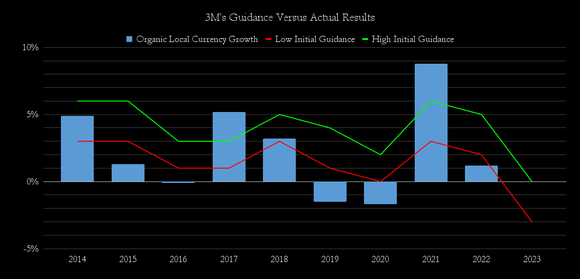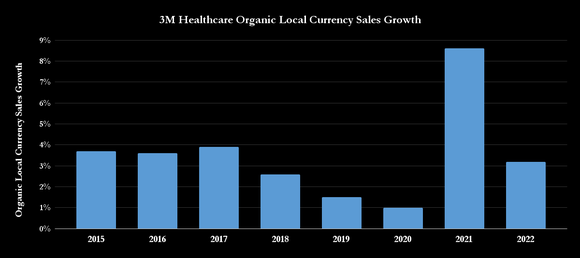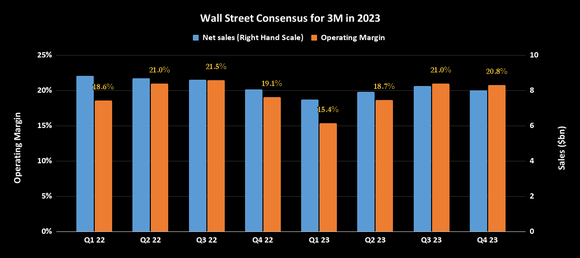The industrial giant's stock is a battleground between bulls and bears. On the one hand, 3M (MMM 1.51%) bulls and income-investing stalwarts think the stock is a good value based on its valuation and history of cash-flow generation. Moreover, they believe the discounted stock valuation is more than enough to compensate for potential legal liabilities. On the other, the bears worry about the legal risk and a consistent record of underperformance. Here are both sides to the story.
The bulls' case
Digging into the details, here's a look at 3M's valuation relative to some of its major industrial peers. Enterprise value (EV) is market cap plus net debt, and EV-to-free cash flow (FCF) is a commonly used valuation metric. 3M trades at a clear discount to its peers -- their average EV/FCF multiple is 31.9. Calculating a theoretical EV for 3M based on the $4.7 in adjusted FCF generated in 2022 gives an EV of $153 billion. 3M had net debt of $11.8 billion at the end of 2022, and stripping that out leaves a market cap of $141 billion.
Given that 3M's market cap is only $56 billion at the time of this writing, the theoretical market cap implies a discount of $85 billion -- a considerable amount to compensate for the potential liabilities coming from 3M's PFAS manufacture and the combat arms earplug issues.
As such, the bulls see 3M as trading on an excellent valuation, support the plan to spin off the healthcare business, and are enthused over its near 5.9% dividend yield.
The bears' case
In response, the bears would argue the following points, which I will flesh out below with the aid of charts for the sake of brevity.
- 3M's history of missing guidance means it deserves a discounted valuation, and that should be the case until management starts overdelivering or at least hits guidance.
- Healthcare is one of its worst-performing businesses, and is not being sold off in a position of strength.
- There's a significant amount of near-term risk around its 2023 earnings guidance.
- Unfortunately, there's been no tangible improvement in the company's revenue growth or margin performance after management's restructuring.
- The dividend could come under threat, not least if the company has cash calls from legal liabilities.
History of missing guidance and weak healthcare performance
As you can see below, 3M's history of generating revenue growth in line with guidance is poor. While the performance in the pandemic-impacted year 2020 is understandable, as is the better-than-expected 2021, 3M's performance has been disappointing across many other years.

Data source: 3M presentations.
Moreover, its least cyclical business, and one in which management has made multi-billion dollar acquisitions, has failed to live up to expectations. On an investor day presentation in 2016, management told investors to expect 4%-6% organic local currency growth from the healthcare segment from 2016-2020, and the same range was put forward in 2019 for the 2019-2023 period.
Here's the reality. 3M's healthcare segment has only beaten the low end of the guidance range in the bounce-back year of 2021. This is particularly concerning given that it's 3M's least cyclical business -- there's no blaming the economy for the long-term underperformance.

Data source: 3M presentations.
Lack of improvement, the near-term risk to guidance, and the threat to the dividend
In response to the underwhelming performance, CEO Mike Roman and CFO Monish Patolawala have tried to restructure the business. The segments were reduced from five to four, the operating model was changed (to a business-led global operation rather than a country-focused model), and the previously mentioned multibillion-dollars worth of acquisition and divestitures took place, mainly in the healthcare segment. Unfortunately, none of it seems to have improved performance in healthcare or overall.
With the company staring down the barrel of a 15% operating margin in the first quarter, 3M has much to do to meet its guidance and Wall Street's estimates. The chart below shows the step-up required in the second half.

Data source: marketscreener.com.
Moreover, 3M's margin performance over the years is nothing to write home about, so the second-half ramp in margin deserves to be questioned.

Data source: 3M presentations.
Throw in the concern that 3M's dividend might not be as safe as many think -- not least if the company faces significant legal liabilities -- and there isn't much left for the bullish case.
Buy, sell, or hold?
Sell, or at least hold off buying until the company can start beating its guidance and maybe take a fresh approach to its underperformance. Perhaps it's time to rethink 3M's model of research-led product development aiming at developing differentiated products that can grow volume.
Instead, 3M could look at Illinois Tool Works' playbook, which involves focusing on developing products based on the requirements of its most important customers while paring less profitable business and product lines. The latter started this process almost 10 years ago, leading to a 270% rise in its share price over the decade and substantive margin expansion, compared to a 4% decline at 3M. Something to consider.

